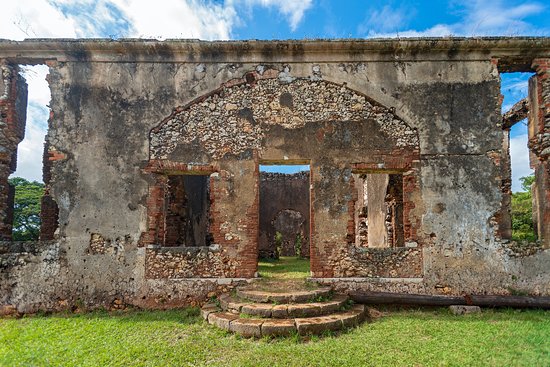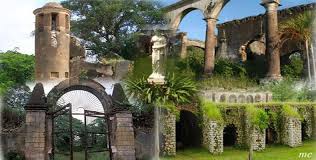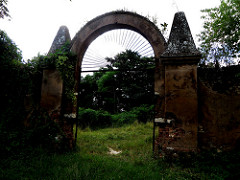 MANSION “ANGERONA”, ARTEMISA, CUBA: REMEMBRANCES OF A GREAT LOVE.
MANSION “ANGERONA”, ARTEMISA, CUBA: REMEMBRANCES OF A GREAT LOVE.
In the province of Artemisa, south of Havana, the ruins of the old “Angerona” coffee plantation and mansion are preserved, whose owner, a German emigrant from Bremen, prospered at the expense of the aromatic grain at the beginning of the 19th century. But Cornelio Souchay never imagined that the attraction for black skin with aromas and fragrances of French perfumes would lead him to an unusual and unforgettable love.
Úrsula Lambert, wealthy and elegant Haitian exiled in Cuba after the slave rebellion in that country, was the one who motivated her to stay. From their meeting in the streets of Havana they felt an attraction much stronger than the moral rigidity and racism that prevailed at that time.
This love had its peak in 1813 when Souchay, for a price of fourteen thousand pesos, bought a farm to which his beloved Úrsula would name Angerona, and which turned into a wonderful Haitian-German coffee empire.
Since then love grew, only his death could stop the passion and feeling among this couple of immigrants that gathers the history of Cuba.
They say that Cornelio Souchay had his five hundred and thirty-eight hectares produced until he took out one hundred and fifty thousand pounds of coffee, always with his enterprising couple, while 450 slaves enjoyed preferential treatment. To honor his love, Cornelio built a manor house of eclectic architecture on a small hill, and at the entrance placed, on a minimal pedestal, the Latin image of the goddess Angerona.
The care of the planting under the perfect order of Souchay and the feminine and harmonious touch of Úrsula, ensured an increasing prosperity to this place. But death played a trick on lovers. On July 13, 1837, this German lover of coffee and Cuban soil abandoned his “oak of smell” forever.
She took with her, during the next twenty-three years she lived, the pain of loss. Then the sugarcane set guidelines as a monoculture and began to gain ground in the emerging economy of the largest Antillean archipelago, displacing coffee. The relentless force of time and oblivion began to take over every corner of Angerona and extinguished their echoes.
The film Roble de olor (Perfumed Oak) was presented in 2005. It was based on that story and the actor Jorge Perugorría took the role of Sochay.
 LA MANSIÓN “ANGERONA”, ARTEMISA, CUBA: RECUERDOS DE UN GRAN AMOR.
LA MANSIÓN “ANGERONA”, ARTEMISA, CUBA: RECUERDOS DE UN GRAN AMOR.
En la provincia de Artemisa, al sur de La Habana, se conservan las ruinas del viejo cafetal y mansión “Angerona”, cuyo dueño, un emigrante alemán venido de Bremen, prosperó a costa del aromático grano a principios del siglo XIX. Pero Cornelio Souchay nunca imaginó que la atracción por la piel negra con aromas y fragancias de perfumes franceses lo llevaría a un inusitado e inolvidable amor.
Úrsula Lambert, acaudalada y elegante haitiana exiliada en Cuba después de la rebelión esclava en ese país, fue quien le motivó para quedarse. A partir de su encuentro en las callejuelas de La Habana sintieron una atracción mucho más fuerte que la rigidez moral y el racismo imperantes en aquella época.
Este amor tuvo su momento cumbre en 1813 cuando Souchay, por un precio de catorce mil pesos, compró una finca a la que su adorada Úrsula nombraría Angerona, y que convirtió en un maravilloso imperio cafetalero haitiano-alemán.
Desde entonces el amor creció, solo la muerte de él pudo detener la pasión y el sentimiento entre esta pareja de inmigrantes que recoge la historia de Cuba.
Angerona, “Roble de Olor”.
Cuentan que Cornelio Souchay hizo producir sus quinientas treinta y ocho hectáreas hasta sacarles ciento cincuenta mil libras de café, siempre junto a su emprendedora pareja, mientras 450 esclavos gozaban de un trato preferencial. Para honrar sus amores Cornelio hizo construir una casa señorial de arquitectura ecléctica sobre una pequeña colina, y a la entrada colocó, sobre un mínimo pedestal, la imagen latina de la diosa Angerona.
El cuidado de la siembra bajo el orden perfecto de Souchay y el toque femenino y armonioso de Úrsula, aseguraron una prosperidad cada vez más creciente a este lugar. Pero la muerte les jugó una mala pasada a los amantes. El trece de julio de 1837 este alemán enamorado del café y de la tierra cubana abandonó para siempre a su “roble de olor”.
Ella llevó consigo, durante los siguientes veintitrés años que vivió, el dolor de la pérdida. Entonces la caña de azúcar sentó pautas como monocultivo y comenzó a ganar terreno en la incipiente economía del mayor archipiélago antillano desplazando al café. La implacable fuerza del tiempo y el olvido comenzaron a adueñarse de cada rincón de Angerona y apagaron sus ecos.
La película ‘Roble de olor’ se presentó en 2005. Y se basó en esa historia y el actor Jorge Perugorría asumió el papel de Souchay.
Agencies/Radio Encyclop/Internet Photos/Arnoldo Varona/TheCubanHistory.com
THE CUBAN HISTORY, HOLLYWOOD.








